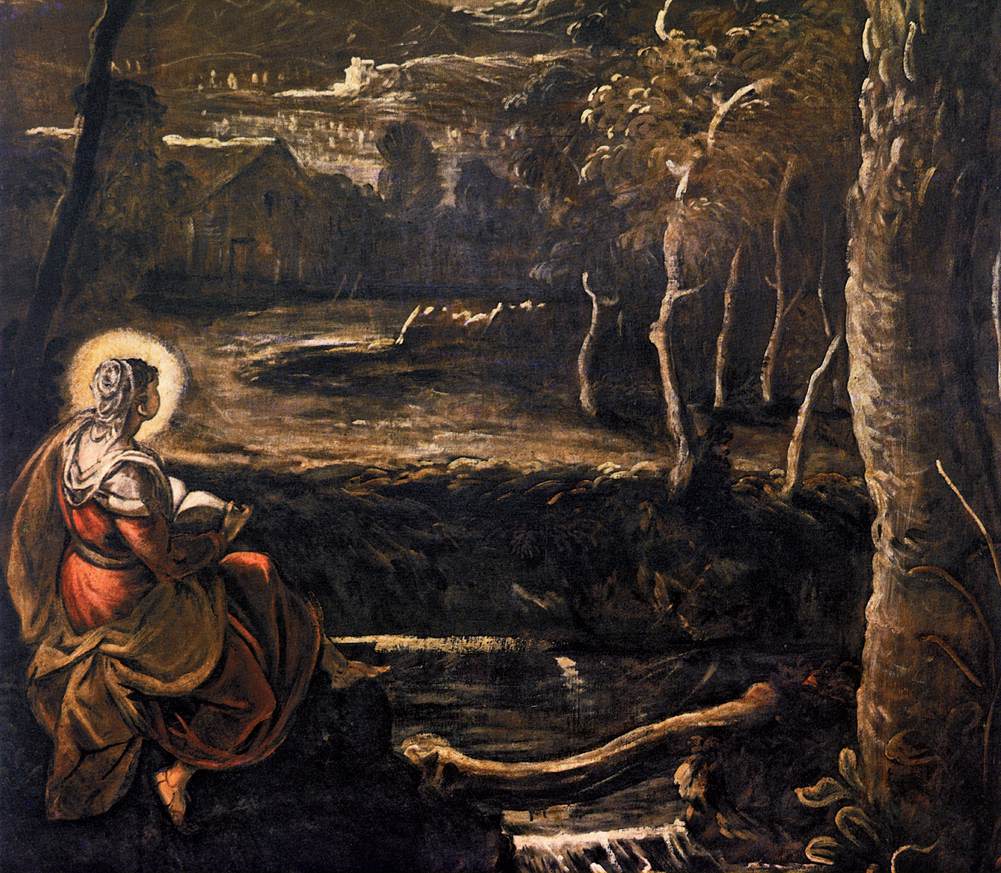
(From Wikimedia Commons)
Since today is the feast day of St. Mary of Egypt, I thought I would repost for you here one of my favorite homilies about her. I preached this two years ago on the Fifth Sunday of Lent.
Sunday of St. Mary of Egypt, April 21, 2013
Rev. Fr. Andrew Stephen Damick
In the Name of the Father and of the Son and of the Holy Spirit, one God. Amen.
Today we remember a woman who walked out into the desert and repented there for more than forty years. On this fifth Sunday of the Great Fast, the Church celebrates St. Mary of Egypt.
Born in the mid-4th century, Mary was a woman dedicated to pleasure. She is sometimes called a prostitute, but that term is not really accurate, because she would not take money in exchange for her wantonness. She was offered it many times, but she would refuse it, and sustained herself primarily by begging. And so she lived this way, constantly seeking out new men to engage in fornication. Being beautiful, she was desired by many, and so she lived an “active” lifestyle. She began this way of life when she was twelve years old, having run away from home to the city of Alexandria.
After seventeen years of what became a more and more tortured way of life, she decided to make a pilgrimage to the city of Jerusalem for the feast of the Exaltation of the Cross in September. But she did not go to celebrate the feast. She was instead hoping to find crowds of pilgrims with whom she could satiate her lust, her constant, overwhelming desire. When she arrived in Jerusalem, she continued in her manner of life, having found new people to lead into her desperation for physical satisfaction.
She eventually was led to enter the Church of the Holy Sepulchre, which includes Golgotha, the place of the crucifixion, within its walls, the holiest place to celebrate the feast of Christ’s Cross. But as she began to enter the doors of that blessed church, she was suddenly stopped by an unseen force. The crowds around her entered, but it was almost as if a great hand was holding her back.
At that moment, something began which the world tells us is really not possible. At that moment, something began which for the world is not in any way desirable. Mary began to repent. And she walked beyond the Jordan River and kept repenting for more than forty years.
When we hear this word repentance, it is likely that we do not hear it as anything positive. It may stir up feelings about guilt. It may sound like judgmentalism or condemnation. It may conjure images in our brains of overbearing, bombastic preachers hurling down sermons on hellfire and brimstone like lightning bolts from angry gods. So why do we talk about repentance so often in the Orthodox Church?
Well, it should probably first be said that there are many so-called churches that have stopped talking about repentance or have tried to massage it out of their message because it is unappealing to their customers—or, I mean, their congregants. And certainly one does not hear about repentance in the public square much any more. It is long since any president declared a day of national fasting and prayer as Abraham Lincoln did in 1863. I daresay there are some things done by those in the public square that need some repentance.
I think there are probably two reasons why repentance is unfashionable. The first is that, as we said earlier, most people have a harsh and painful image of what it means to repent. It is demeaning. It is hard. It is annoying. The second reason is just that we like sin—another word that doesn’t get used too much in public any more.
But since we are Orthodox Christians, we recognize that we need to repent. And since the public proclamation of the Gospel has always begun with the exhortation “Repent, for the Kingdom of God is at hand,” first in the mouth of John the Baptist and then from his cousin the Lord Jesus Christ, we should ask what repentance really is. And then we should ask why we should not flee from repentance but should actually want it. And this will tell us how someone like St. Mary of Egypt could keep repenting for so very long.
The word for “repentance” in Greek is metanoia, and it consists of two different Greek words—meta and nous, with the latter word being changed by the compound. Meta can mean many things, but here it means “change” or “turning.” And the nous is the innermost sense of human beings, the faculty with which we apprehend divine, mystical reality. It is the “heart” or the “eye of the soul.” So metanoia—repentance—is the turning of the eye of the soul, the changing of the heart. It is to direct our innermost gaze away from what is sinful, what separates us from God’s life, and toward what is good, what connects us with the life of our Maker.
That is the etymological and theological description of what repentance means. But for us to understand repentance, I think we may need some illustrative imagery. The place where Mary of Egypt went to engage in her repentance was the desert beyond the Jordan River. There it is said that she watered the place with her tears, the tears she shed over her many years of evil and self-destruction.
And that is what sin does. It is not just a transgression against some cosmic law. It is self-destruction and nothing less. Sometimes the destruction is sudden and devastating, but other times it is the slow dehydration that turns what is fertile into the barrenness of the desert. That is what happened to much of the Middle East, by the way—so much of it was fertile, but through gradual overuse and misuse of the land, it became desert. So it is with human persons. What is beautiful and fertile and full of possibility becomes, over time, bit by bit, dry and thirsty.
Yet repentance is possible. When a soul repents, the rain begins to fall. Sometimes the rain may bounce off the hard ground because it is so unused to receiving it, and so it may seem to do nothing or even to hurt. But over time, the rain begins to soak the land. And where there may at first be mud and erosion, there eventually comes to be fertility and growth.
Repentance is the springtime of the soul, and is it any wonder that we are now in this Lenten season of repentance, right now, at springtime? Even the very word Lent itself actually means “springtime.” We pour repentance into our souls by shedding those things that weigh us down, those useless burdens of sin that look and feel so good but actually are deeply dangerous to us. And when that repentance comes pouring in, all the many virtues of our souls, like flowers in a garden, begin to awaken, to bud and to bloom. They have been sleeping during the long winter of sin, but now they can grow.
To repent is not to feel guilty. Guilt may encourage us to repent, but it doesn’t always. Guilt is just the pain at recognizing the desert that our souls have become. But pain isn’t repentance. To repent is to turn, to change, to come back to life. We have to see that we have a desert in our souls, and sometimes it takes the upheaval of disaster, depression, divorce, drugs or death to see it. But it doesn’t have to take that. Seeing the desert within may also be inspired by contact with true beauty. Seeing the beauty of Eden, the beauty of Paradise, in the love of our Lord, we realize that we live in the desert. And we want Eden.
And so we repent. We turn back to Eden. We turn to the divine life of Christ, the life of the Holy Trinity granted in communion with the Son of God. This is what it means to repent! It means that we who are dead can be made alive, that we who are dry and thirsty may become fertile and full, that we who are addicted might be set free.
And that is how Mary of Egypt could live in that desert for decades. She was not out there moping around feeling guilty. She was watering her garden. She was tending to the flowers of virtue in her soul. She was walking with God in Eden, just as Adam and Eve had once done. She who had been a desert in the midst of fertility became a walking Paradise in the midst of the desert.
Has this Great Lent been the springtime of your soul? Even if it has not yet been, it still may be. There always is hope. There always is mercy. There always is possibility. Let us repent with joy, brothers and sisters, and so pour the grace of God like long-awaited rain into the desert of our souls.
To our life-giving God, the Father and the Son and the Holy Spirit, be all glory, honor and worship, now and ever, and unto ages of ages. Amen.



Thank you Father Damick for a beautiful sermon on repentance.
Thanks, Father, for this sermon. I never really thought about how living in repentance actually mea d living in Joy.
Truly beautiful! Thank you, Father!